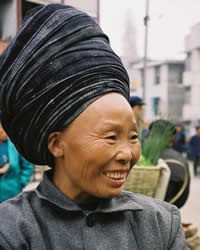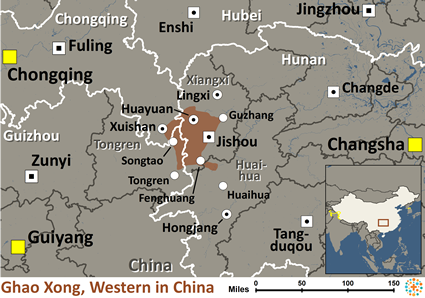The virtually inaccessible mountains where the provinces of Hunan, Sichuan, and Guizhou meet were the site of countless wars involving the Ghao-Xong. The Qing Emperor Kangxi (1662-1722) issued an edict that "the rules governing them should be different from those enforced elsewhere in China." It took the Chinese 18 years (1855-1872) to crush one rebellion. According to a memorial, "When reaching a Miao village, the government troops slaughtered rebels and those who had surrendered."
The Western Ghao-Xong have been called several different names in the past, including Huayuan Miao, Red Miao, and West Hunan Miao. They are part of the Miao nationality, but they speak a language different from all other Miao groups in China. Their dress and customs are also different. Most Miao in Hunan call themselves Ghao-Xong, in contrast to other Miao groups such as the Hmong, Hmu, Gha-Mu, and A-Hmao.
The Ghao-Xong celebrate the Siyueba Festival on the eighth day of the fourth lunar month. "Many centuries ago, there were Miao [Ghao-Xong] people living by the River Longtang at the foot of the Fenghuang Mountains in Western Hunan. No longer able to bear the oppression they suffered under the rule of the Qing Dynasty (1644-1911), they rose in revolt under the leadership of two brothers, Yayi and Yanu. ... Yayi was killed in battle. Yanu led the remnants of his forces into safety in Guizhou. ... To commemorate their heroes the Miao [Ghao-Xong] people gather to hold a ceremony at which they sing, dance and perform traditional rites."
The Western Ghao-Xong people's high mountain lifestyle shows their longstanding values of perseverance and freedom.
The Ghao-Xong (along with the She and Yao minorities) worship Pan Hu, the dragon-dog they claim as the forefather of their people. The Pan Hu myth was recorded as early as the fifth century AD in the Chronicles of the Later Han Dynasty (Hou Han Shui).
The work of the Catholic Passionist missionaries was hindered by their inability to speak either Ghao-Xong or Chinese fluently. One missiologist remarks, "Little wonder then, that in Hunan there does not appear to be any large-scale turning of the Miao [Ghao-Xong] people to Christ." The western Hunan region was largely neglected by Protestant missionaries prior to 1949. Today, the majority of Ghao-Xong have never heard the gospel.
Without the guidance of Christ, these people will be spiritually lost in this life and the life to come. They need someone to go to them as Christ-bearers.
Pray for the Lord to intervene in their families, calling people to his side.
Pray for loving, anointed workers.
Pray for their hearts to be drawn to the Lord of lords.
Pray for a church planting movement to thrive in their communities.
Scripture Prayers for the Ghao-Xong, Western in China.
Operation China, Asia Harvest, Copyrighted © Used with permission
| Profile Source: Joshua Project |

























